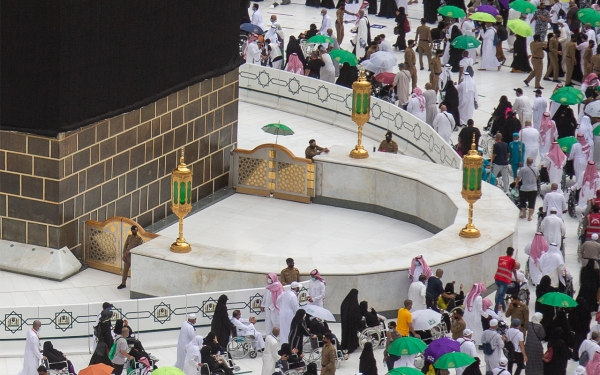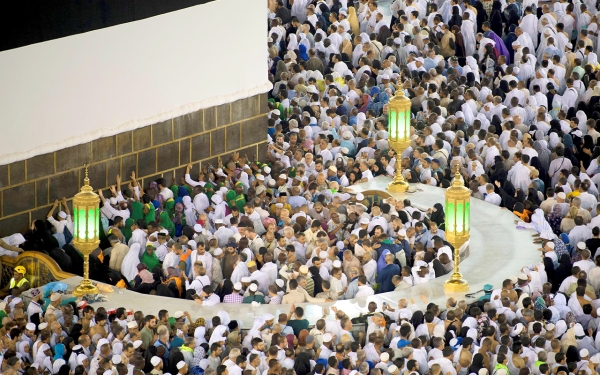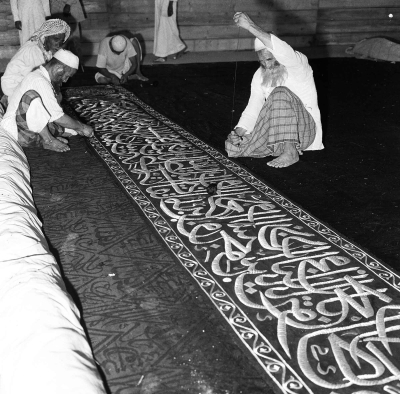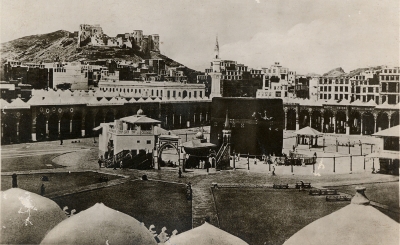

Hijr Ismail is a crescent-shaped wall adjacent to al-Kaaba al-Musharrafa from its northern side. It has short wooden doors on both the eastern and western sides that connect it to al-Kaaba when closed. In its center, the rains pour into the Kaaba's rainwater drainage system (Meezab-e-Rahmat), and it is the only side of al-Kaaba where the Shadherwaan is at a lower level.
Hijr Ismail's association with al-Kaaba al-Musharrafa
Hijr Ismail is closely associated with al-Kaaba al-Musharrafa, and historical accounts regarding it are numerous. There is a consensus among scholars and researchers that it is an integral part of al-Kaaba and cannot be separated from it. It has several names, each with a different meaning. The length of Hijr Ismail is currently estimated at one m, measured from the center of its inner wall to the northern outer wall of al-Kaaba, which is approximately 8.46 m.
Names of Hijr Ismail
Historical sources have agreed on five names for Hijr Ismail, the most famous of which are:
- The name Hijr was given to it because it is a part of al-Kaaba al-Musharrafa. Yaqut al-Hamawi explained this by saying that when the Quraysh were building al-Kaaba, they left it in place from the foundations laid by the Prophet Ibrahim peace be upon him (PBUH) to indicate that it is part of al-Kaaba.
- The name al-Juder is derived from a narration about Prophet Muhammed (PBUH), in which a man asked him: Have you seen al-Hateem? The Prophet clarified: It is not called al-Hateem; rather, during the era of Jahiliyyah, it was known as al-Hateem. It is actually called al-Juder. Al-Jawhari described it as what al-Hateem encircles around al-Kaaba on the northern side.
- Hijr Ismail comes from historical narrations that describe how Prophet Ibrahim (PBUH) made it a shelter for Ismail, where he sought refuge along with his flock. It was covered with a shelter made from the wood of the arak tree, which is abundant in the valleys of Makkah al-Mukarramah.
- The name Hufrat Ismail gained fame because it refers to the hollow space that existed before the foundations of al-Kaaba were raised and it was built.
- Al-Hateem is a location below the Meezab-e-Rahmat and is named as such because it is separated from al-Kaaba and is damaged. Some say it is called al-Hateem because people raise their voices in faith at this spot.
The restoration of Hijr Ismail
The successive caliphs have been involved in the restoration and repair of the Hijr Ismail over the past historical periods until it reached its current form. The Abbasid Caliph al-Mahdi Billah had intentions to return it to al-Kaaba, but Imam Malik refused this idea, arguing that the Prophet (PBUH) circumambulated it as it was without changing or instructing any changes to it. The Quraysh tribe, during the construction of al-Kaaba, left a portion of the structure incomplete and undone, as narrated in Sahih Muslim on the authority of Aisha (may Allah be pleased with her). She reported that the Messenger of Allah peace be upon him said: "For your people had reduced the area of the Kaaba when they built it. If they had not recently been polytheists, I would build it upon the original. So if it seems good to your people to build it after me, then come so that I could you show what they left out from it. Then, he showed her about seven cubits."
Hijr Ismail paved with marble
The first person to pave Hijr Ismail with marble was Caliph Abu Ja'far al-Mansur in the year 757. It underwent reconstruction by several princes and rulers over time, eventually taking its current form during the reign of King Khalid Bin Abdulaziz Al Saud in the year 1977. It was paved with Greek cold marble, in line with the rest of the circumambulation area, and three decorative illuminated lanterns were placed on it.
Maintenance of the Hijr Ismail during the Saudi era
As part of the restoration work on al-Kaaba in 1996, which was carried out during the reign of King Fahd Bin Abdulaziz Al Saud, the old marble of Hijr Ismail was replaced with newer marble. Additionally, the lanterns were maintained and renewed, and barriers made of ropes were introduced at the entrances to the Hijr to close it when necessary. The latest renovation of the marble and lanterns of Hijr Ismail took place in 2014. Periodic maintenance of Hijr Ismail is carried out by the General Presidency for the Affairs of the Grand Mosque and the Prophet's Mosque, which includes leveling the interior floors of the Hijr, polishing the marble floors, and painting the wooden part of the Hijr's door.
Related quizzes


